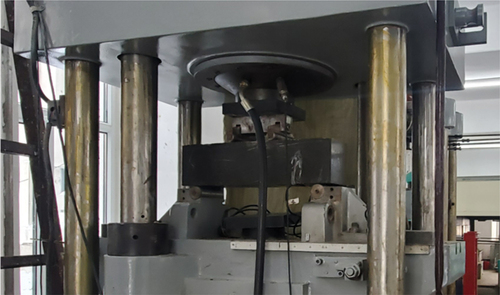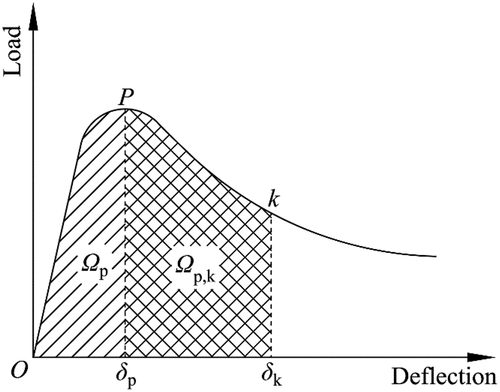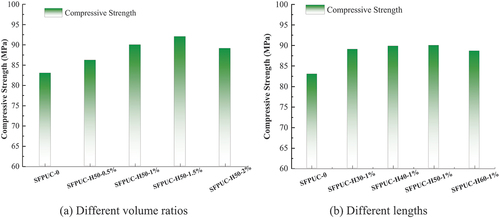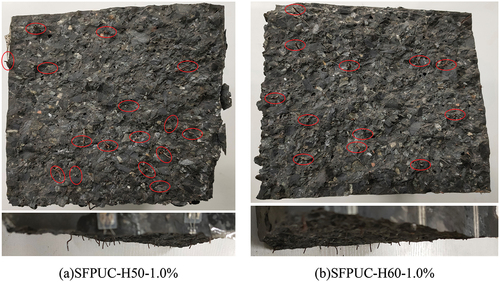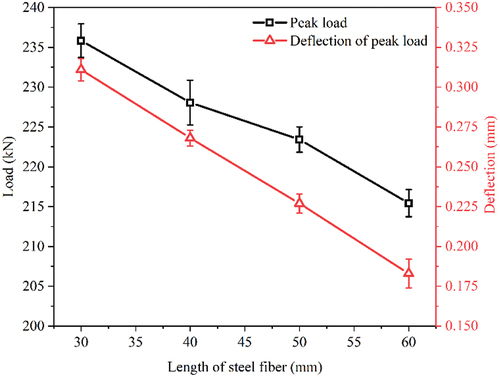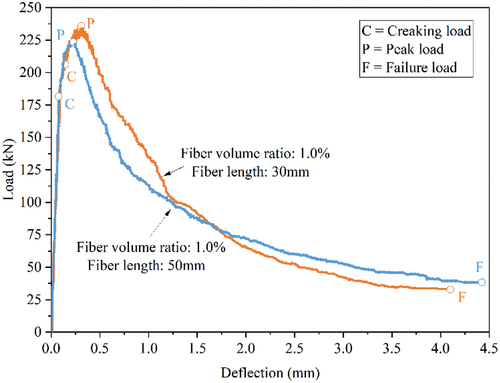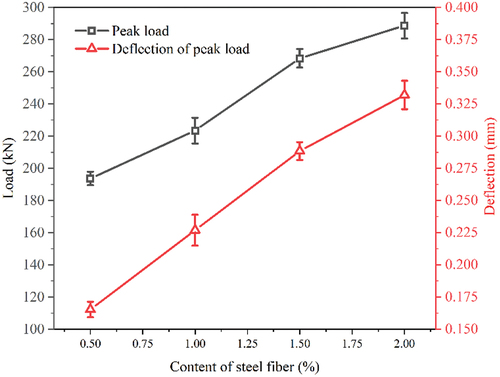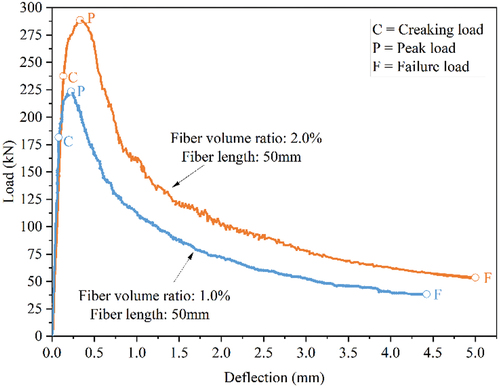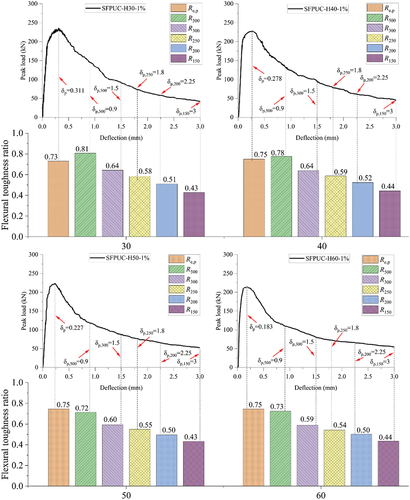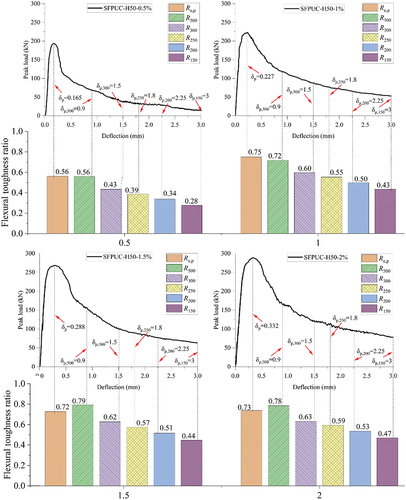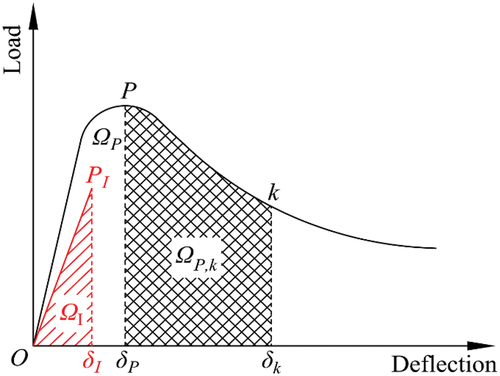 ?Mathematical formulae have been encoded as MathML and are displayed in this HTML version using MathJax in order to improve their display. Uncheck the box to turn MathJax off. This feature requires Javascript. Click on a formula to zoom.
?Mathematical formulae have been encoded as MathML and are displayed in this HTML version using MathJax in order to improve their display. Uncheck the box to turn MathJax off. This feature requires Javascript. Click on a formula to zoom.ABSTRACT
Polyurethane concrete has excellent mechanical properties, rapid solidification and durability, but brittle damage is easy to occur at room temperature. To solve the problem of insufficient bending toughness of polyurethane concrete, steel fibers were added into the traditional polyurethane concrete to prepare steel fiber polyurethane concrete in this paper. A total of 8 test beams with dimensions of 150 mm × 150 mm × 550 mm were made. The influence of steel fibers with different length-diameter ratios and volume ratios on the flexural strength of polyurethane concrete was studied through four points bending tests. The results show that under the same volume ratio and diameter, as the length of steel fiber increases from 30 mm to 60 mm, the peak load decreased by 8.6%, and the displacement corresponding to the peak load decreased by 41.1%. Under the same length-diameter ratio, the steel fiber volume ratio from 0.5% to 2.0%, the peak load increased by 49.1%, and the displacement corresponding to the peak load increased by 100.8%. The toughening degree, relative initial flexural toughness ratio and relative residual flexural toughness ratio were proposed, and the inconsistencies of calculation criteria for flexural toughness in steel fiber reinforced concrete (JG/T 472–2015) were optimized.
1. Introduction and literature review
At present, most of the research in the field of engineering is to solve practical problems (Nagarajaiah and Narasimhan Citation2007)- (Wang et al. Citation2023). Constantly improve the performance of materials, improve the safety and stability of the structure, are the direction of our exploration and efforts (Wang et al. Citation2022)- (Wang et al. Citation2023).
The bridge expansion joint anchorage area is one of the most frequently damaged components of the bridge structure. Although the cost of bridge expansion joints accounts for only about 1% of the total cost of the bridge structure, about 16% of the bridge damage occurs at the bridge expansion joints (Lima and Brito Citation2009). It is critical to emphasize that the repair cost of expansion joint damage accounts for as much as 20% of the total bridge repair cost (Lima and Brito Citation2010), which leads to an increase in bridge maintenance costs. Performing frequent maintenance on expansion joints can result in significant direct and indirect economic losses, as well as adverse social impacts due to traffic disruptions during maintenance. Since bridge expansion devices are often located in municipal or highway node sections, they cannot be closed to traffic for extended periods of time. Therefore, the material used to repair the bridge expansion joint anchorage zone must be quick-setting, high strength, and durable.
Polyurethane concrete is a novel composite material prepared from polyurethane binder, cement, gravel aggregate and additives, etc. It has the characteristics of high strength, rapid setting and hardening, wear resistance, corrosion resistance, high bond strength and excellent fatigue performance (Ding et al. Citation2021). The polyurethane concrete formed by dolerite aggregates as a filler and polyurethane as a binder not only has excellent mechanical properties but also has great corrosion resistance (Jiang et al. Citation2022). Compared with conventional asphalt and cement concrete, polyurethane concrete has good frost resistance, wear resistance and flexural fatigue resistance. The setting and curing rate of polyurethane concrete can be adjusted by adding phosphate ester, and phosphate ester has no effect on the durability of polyurethane concrete (Li and Yu Citation2022). The mechanical properties of polyurethane concrete are influenced by temperature, which has a significant effect on the damage pattern of polyurethane concrete (Wang et al. Citation2021). The specimen undergoes brittle damage at low temperatures and plastic damage at high temperatures (Ding et al. Citation2021). As the temperature increases, the cubic compressive strength, splitting tensile strength, axial compressive strength and modulus of elasticity decrease and the peak strain increases (Lei et al. Citation2022). Even though the temperature has some unfavorable effect on the strength of poly-urethane concrete, the compressive strength of polyurethane concrete is higher than that of fly ash concrete and ordinary concrete in a hot and dry environment of 80℃, which enables polyurethane concrete to maintain excellent mechanical properties in a harsh and high temperature environment (Zhao et al. Citation2022). Changing the content of hard sections and the length of soft sections is an effective way to adjust the engineering properties of polyurethane concrete. The soft and hard segments in polyurethane are the critical determinants of the mechanical properties of polyurethane (Huang et al. Citation2021). Increasing the content of hard segments or larger molecular weight of soft segments are effective in enhancing hydrogen bonding and microphase separation (Lei et al. Citation2022). The damping ratio of polyurethane concrete is 8.2%, which is 4.3 times higher than that of ordinary concrete. At 50 Hz, the damping ratio of polyurethane concrete beams is 9.5%, which is about 12 times (0.8%) of that of ordinary concrete beams (Lee et al. Citation2018). This property can effectively cushion the impact of vehicle loads on the anchorage area of expansion joints.
As polyurethane concrete is gradually promoted and applied, the deficiencies of polyurethane concrete are also gradually discovered. It is reported that polyurethane concrete is mostly brittle damage at room temperature or low temperature (Ding et al. Citation2021; Lei et al. Citation2022), and its poor flexural toughness limits the further application of polyurethane concrete. High strength and excellent toughness are prerequisites for the safety of engineering structures. To solve the problem of the insufficient toughness of polyurethane concrete, Ding (Ding et al. Citation2021) designed a new carbon fiber grating-polyurethane concrete system, so that the carbon fiber grating and polyurethane concrete have a good synergistic force effect. A fatigue-resistant elastic polyurethane concrete (EPUC) was obtained by adding waste rubber particles to conventional polyurethane concrete. The addition of rubber granules filled the interior of EPUC with tiny elastic structures, which effectively optimized the interfacial bonding between aggregates and polyurethane and improved the toughness of polyurethane concrete (Jia et al. Citation2021).
The addition of fibers is the most common means of toughening in engineering. Polyurethane-based composites have good compatibility and can be prepared into fiber-reinforced polyurethane composites with glass fibers (Du and Liu Citation2021), carbon fibers (Ma et al. Citation2019), polyethylene fibers (Feng et al. Citation2021), plant fibers (Mastura et al. Citation2018). The fibers processed by the modifier are more helpful to enhance the interfacial shear strength of polyurethane and fibers (Guo et al. Citation2018), and the modified fibers have better interfacial bonding with the polyurethane matrix (Meng et al. Citation2018). The polydopamine on the surface of ultra-high molecular weight polyethylene (UHMWPE) fibers can react with polyurethane to form chemical bonds, which improves the mechanical strength of the composites. Compared with pure polyurethane, the tensile strength, interlaminar shear strength and impact strength of the UHMWPE fiber-reinforced polyurethane composites were increased by 97.8%, 35.85% and 2456.9%, respectively (Feng et al. Citation2021). Plant fiber and polyurethane-based material composite can be prepared partially biodegradable green composites (Li et al. Citation2019), flax fiber can enhance the mechanical properties of polyurethane composites, the mechanical properties of polyurethane were enhanced by more than 40% through 15% doping of flax fiber (Sair et al. Citation2018), the Young’s modulus of polyurethane was also significantly increased (Mastura et al. Citation2018). The degree of phase separation of polyurethanes can be reduced by plant fibers (Lei et al. Citation2018)- (Radzi et al. Citation2018), and thus the properties of polyurethane-based composites can be improved. In an effort to enhance the mechanical properties of polyurethane concrete, researchers have experimented with adding steel fibers to the matrix. For instance, Zia A (Zia et al. Citation2022) mixed waste tire steel fiber into cement composite material to explore the change of its mechanical properties. Song (Song and Yin Citation2016) mixed steel fibers with carbon fibers to improve the compressive and impact toughness of concrete. Choi (Choi et al. Citation2019) studied the effect of different sizes, shapes and contents of steel fibers on the flexibility of concrete, and also used an improved toughness index to quantify the flexibility. Yahye (Yahye et al. Citation2022) studied a new type of fiber-reinforced polyurethane concrete (FRPEC), adding 13 mm steel fibers to improve the strength and toughness of FRPEC. As can be seen from the above, the mechanical properties of various fiber reinforced concrete have been studied by researchers at present, but the toughness of steel fiber reinforced polyurethane concrete is less studied. The study of failure mechanism and toughening mechanism of steel fiber polyurethane concrete is limited, especially the toughening effect of end tip steel fiber with different length-diameter ratio and volume ratio on polyurethane concrete needs further study.
This paper aims to study the influence of length-diameter ratio and volume ratio of steel fiber on bending behavior of polyurethane concrete. Eight 150 mm × 150 mm × 550 mm polyurethane concrete test beams were fabricated and tested under four-point bending. Four types of steel fibers with length-diameter ratios of 40, 53, 66 and 80 were selected, and the volume ratios were 0.5%, 1.0%, 1.5% and 2.0%, respectively. The toughening effect of steel fiber with different length-diameter ratios and volume ratios on polyurethane concrete was studied, and the changes of flexural strength and flexural toughness of polyurethane concrete were revealed. The calculation criteria of bending toughness in Steel fiber reinforced concrete (JG/T 472–2015) (M.o.H.a.U.-R.D.o.t.P.s.R.o Citation2015) were optimized. Three indexes of toughening degree, relative initial bending toughness ratio and relative residual bending toughness ratio were proposed to evaluate the bending toughness of the test beam. This work is of great significance to better understand and evaluate the flexural toughness of steel fiber polyurethane concrete.
2. Materials and Methods
2.1. Materials
2.1.1. Isocyanate
The isocyanate used in this paper is polyaryl polymethylene isocyanate (PAPI), which is also known as polymeric MDI. The main components of the PAPI are diphenylmethane diisocyanate (MDI) and oligomeric isocyanates with 3–6 functional groups. Its physical and chemical properties were tested by the standard method specified in GB/T 611–2006 (AQSIQ Citation2006) and GB/T 12,009.2 ~ GB/T 12,009.5 (AQSIQ Citation2016a)- (AQSIQ Citation2016c). The test results are listed in .
Table 1. Physical and chemical properties of isocyanate.
2.1.2. Polyether polyol
The main components of the combined polyether polyol are polyether polyol, chain extender and crosslinker. The physical and chemical properties of combined polyether polyol were tested by the standard method specified in GB/T 12,008.7 (AQSIQ Citation2010b), GB/T 12,008.3 (AQSIQ Citation2010a), and GB/T 611–2006 (AQSIQ Citation2006). The test results are shown in .
Table 2. Physical and chemical properties of combined polyether polyol.
2.1.3. Catalyst
The catalyst used in this paper is an aliphatic amine catalyst among tertiary amine catalysts, which is a solution with triethylenediamine as the main component and has a colorless and transparent liquid appearance.
2.1.4. Molecular sieve
The isocyanate reacts with water to form polyurea and carbon dioxide gas, and a small amount of water can produce a large amount of carbon dioxide gas (Zhang and Sun Citation2018). As other polymerization reactions proceed, the polyurethane viscosity gradually becomes larger causing difficulty in expelling the gas inside the polyurethane. Eventually, the volume of polyurethane expands rapidly and leaves more pores inside, which affects the performance of cured polyurethane concrete. Therefore, in this paper, molecular sieves are added to the mixture to adsorb the water. The physical and mechanical properties of 5A Molecular sieve were tested by the standard method specified in GB/T 13,550–2015 (G.A.o.Q.S. I.Q.o.P.R.o.C Citation2015). The size of 5A molecular sieve ranges from 2 μm to 4 μm. The stacking density is 0.45 g/mL, the static water adsorption rate is 25%, and the pH value is 9.
2.1.5. Cement
The physical and mechanical properties of PO 42.5 cement were tested by the standard method specified in JTG 3420 (M.o.T.o.t.P.s.R.o Citation2020). The test results are shown in .
Table 3. Physical and mechanical properties of cement.
2.1.6. Aggregate
The basic physical properties of granite aggregate were tested by the standard method specified in JTG E42–2005 (M.o.T.o.t.P.s.R.o Citation2005). The apparent density of granite aggregate is 2.767 g/m3, the total bulk density is 2.683 g/m3, the volume porosity is 38.5%, the crushing value is 23.1%, and the content of needle and sheet materials is 3.4%.
2.1.7. Steel fibers
The steel fibers used in this study are end-hooked steel fibers. The main parameters are shown in .
Table 4. Physical and mechanical properties of granite aggregate.
2.2. Preparation of polyurethane concrete
2.2.1. Preparation of polyurethane concrete
The preparation of polyurethane concrete is mainly divided into drying aggregate, mixing by combined polyether polyol, mixing by isocyanate and catalyst, mixing with steel fiber for several times, and finally pouring. Release mold after 24 hours of curing at room temperature. The detailed preparation steps can be referred to the method in the previous research results (Ding et al. Citation2021). It is noting that to disperse the steel fibers evenly, they need to be added to the mixture in small amounts and in multiple passes. Due to the catalyst, the polyurethane concrete cures quickly and all specimens were ready to be demolded after 24 h of casting. The mix of polyurethane concrete is shown in . Physical and mechanical properties of polyurethane concrete are shown in .
Table 5. Polyurethane concrete mixture (by mass).
Table 6. Physical and mechanical properties of polyurethane concrete.
2.2.2. Test plan
As shown in , four lengths of steel fibers were used to investigate the effect of steel fiber length on the flexural properties of polyurethane concrete. Four steel fiber volume rates were used to investigate the effect of steel fiber content on the flexural properties of polyurethane concrete. SFPUC-0 is the polyurethane concrete without steel fiber.
Table 7. Test plan for steel fiber polyurethane concrete.
2.3. Test method
2.3.1. Flexural test
As shown in , the flexural test is conducted by the method specified in JTG 3420 (M.o.T.o.t.P.s.R.o Citation2020), the loading instrument adopts electro-hydraulic servo pressure testing machine, the maximum loading force is 3000kN. The displacement and strain data are collected by Yangzhou Jingming JM3816A multifunctional strain collection system. The specimen size of 150 mm × 150 mm × 550 mm and the loading rate of 0.08 MPa/s. Flexural strength is calculated according to EquationEquation (1)(1)
(1) , and the results are accurate to 0.01 MPa. The final test result was the arithmetic mean of the test values of three parallel specimens.
Where ƒƒ is the flexural strength (MPa); L is the distance between supports; F is the ultimate load (N); b is the specimen width (mm); h is the specimen length (mm).
2.3.2. Flexural toughness evaluation method
Flexural toughness is a comprehensive index to evaluate the performance of fiber concrete mechanics, deformation and energy absorption. In this study, the flexural toughness of steel fiber polyurethane concrete was evaluated by Chinese JG/T 472–2015 standard (M.o.H.a.U.-R.D.o.t.P.s.R.o Citation2015).
Flexural toughness of fiber reinforced concrete before peak load is characterized by the initial flexural toughness ratio Re,p and flexural toughness of fiber reinforced concrete after peak load is characterized by the residual flexural toughness ratio Re,k. Re,p and Re,k are calculated by equations (2) and (4), respectively. The flexural toughness parameters are shown in .
Where Re,p is the initial flexural toughness ratio; fftm is the flexural strength, (MPa); fe,p is the equivalent initial flexural strength, (MPa); δp is the deflection corresponding to the peak load of the load-deflection curve, (mm); Ωe,p and Ωp,k are the area under the load-deflection curve before the deflection δp and δp,k, respectively, (N∙mm); L is the distance between the two pivot points, (mm); Re,k is the residual flexural toughness ratio; fe,k is the equivalent residual flexural strength, (MPa); δk is the given calculated mid-span deflection L/k (k = 500, 300, 250, 200, 150), (mm)
3. Result and discussions
3.1. Flexural properties of polyurethane concrete with different length of steel fiber
In order to explore the influence of steel fiber on the compressive properties of polyurethane concrete, 150 mm × 150 mm × 150 mm standard cubic compressive specimens were made. Three specimens in each group were selected for compressive tests, and the average value of each group was taken as the test result. The test results are shown in the .
In order to clearly characterize the broken form of steel fiber in polyurethane concrete. The number of fibers in each Fracture section of eight test beams was calculated and the Fracture ratio was used to describe the proportion of fractured fibers to the total number of fibers in the fracture section. The typical cross-sectional distribution of steel fibers is shown in . The bending test results of all test beams are shown in .
Table 8. The bending test results of the test beam.
As can be seen from and , under the same volume ratio, the number of fractured steel fibers with a length of 50 mm is significantly greater than that with a length of 60 mm. The shows that the fracture ratio of 30 mm fiber length is 81.6%, and that of 60 mm fiber length is 69.2%. The number of fractured steel fibers is far greater than that of stretched steel fibers (Abbas, Soliman, and Nehdi Citation2015). Therefore, the number of steel fibers in the cross section of the beam is a key factor affecting the peak load. Under the condition of the same volume ratio and diameter, the longer the length of steel fiber and the larger the length-diameter ratio, the less the number of steel fiber in cross section, which leads to a reduction in the mechanical property enhancement of polyurethane concrete by the fibers. As the length of steel fibers increases, the distribution may be uneven, so the number of steel fibers toughening effect is greater than the geometric length of steel fibers, which is consistent with the study results in reference (Kim, Yang, and Joh Citation2018) and (Yoo a, Kang b, and Yoon Citation2014).
3.1.1. Peak load and deflection of peak load
To investigate the effect of different steel fiber length on the flexural performance, polyurethane concrete under different length of steel fibers was tested, and the test results are shown in . The increase in the length of steel fibers in polyurethane concrete from 30 mm to 60 mm decreases the peak load by 8.6% and the displacement corresponding to the peak load by 41.1%, which indicates that the flexural performance of polyurethane concrete decreases with the increase in the length of steel fibers. In the bending process, cracks appear in the tensile zone of the specimen after reaching its tensile ultimate strength, and gradually expand to the compressive zone. When the content of steel fibers is constant, the short fibers are better able to capture the growth of microcracks (Magureanu et al. Citation2012).
3.1.2. Load-deflection behavior
As shown in , Variation in the length of the steel fibers do not significantly affect the stiffness of the linear elastic section of the steel fiber polyurethane concrete (Portion 0C in ). However, the shorter fibers improve the strain hardening behavior (The phenomenon where the mechanical properties of a material continue to increase as the load continues to increase after the material has reached the crack load (Ding et al. Citation2019)) of polyurethane concrete (Portion CP in ), and the shorter fibers are better able to capture the crack growth for the same steel fiber content (Abbas, Soliman, and Nehdi Citation2015)- (Kim, Yang, and Joh Citation2018). Specimen containing shorter fibers exhibits greater cracking load (When the load deflection curve starts to show a turning point and noticeable cracks can be observed on the surface of the specimen, the load at this point is the crack load of the specimen (Ding et al. Citation2019)- (Hussain et al. Citation2019)) and cracking deformation than that of containing longer steel fibers. Compared with the specimen containing 50 mm fibers, the cracking load and cracking deflection of the specimen containing 30 mm fibers increases by 13.5% and 89.6%, respectively; the peak load and deflection of peak load increase by 5.6% and 37.1%, respectively. For the same steel fiber content, the short fibers have a greater density of distribution inside the polyurethane concrete. The steel fibers exert a more intensive restriction on the crack tip and the crack development is better inhibited.
3.2. Flexural properties of polyurethane concrete with different content of steel fiber
3.2.1. Peak load and deflection of peak load
To investigate the effect of different steel fiber content on the flexural performance, polyurethane concrete under various content of steel fibers was tested, and the test results are shown in . The flexural properties of polyurethane concrete increase with the steel fiber content. As the steel fiber content increases from 0.5% to 2.0%, the peak load and displacement of peak load increase by 49.1% and 100.8%, respectively. At a constant length of steel fibers, the greater the steel fiber content the greater the density of steel fiber distribution within the polyurethane concrete. The development of cracks during bending can be better limited by the higher distribution density of steel fibers (Kim, Yang, and Joh Citation2018). Therefore, the peak load and the displacement corresponding to the peak load of polyurethane concrete rise with the increase of steel fiber content. The greater content of steel fibers enabled higher peak loads and better deformability of the polyurethane concrete.
3.2.2. Load-deflection behavior
As shown in , Variation in the content of steel fibers do not significantly affect the stiffness of the linear elastic section of steel fiber polyurethane concrete (Portion 0C in ). The steel fiber content improves the strain-hardening behavior of polyurethane concrete (Portion CP in ). The steel fiber content raises the cracking load and cracking deflection of the specimens. Compared with the specimens with 1.0% fiber content, the cracking load and cracking deflection of the specimens with 2.0% fiber content increase by 30.7% and 73.8%, respectively; the peak load and peak load deflection increase by 29.2% and 46.3%, respectively. It can be seen that the growth of steel fiber content can effectively improve the flexural properties of polyurethane concrete. Specimen with higher steel fiber content exhibits better softening behavior (Portion PF in ), and maintain a higher load-holding capacity despite the increasing deformation.
3.3. Toughening mechanism of steel fiber polyurethane concrete
The steel fiber allows the polyurethane concrete matrix to bind to each other internally and to exhibit plasticity when damaged. From the appearance, it can be seen that the surface of the steel fiber exposed after damage is very rough, and a lot of polyurethane concrete is attached, reflecting the good bonding between the steel fiber and polyurethane concrete. The failure process of steel fiber polyurethane concrete can be divided into the following three phases based on the failure conditions observed in mechanical properties tests and combined with microscopic morphological features.
Preliminary state: In steel fiber polyurethane concrete, the matrix and the steel fiber are under cooperative forces. At this point, the internal defects of the matrix will slowly increase, mainly due to matrix failure. When a local failure of the matrix occurs, the fiber becomes the dominant force. Failure state: With further increase in load, the steel fiber reaches the failure limit state. During this process, the steel fiber damage mainly takes the form of steel fiber pulling out, as shown in . The steel fiber is broken, as shown in . The failure of the end bond of the steel fiber is shown in . The three failure modes of the steel fiber not only increase the energy absorption from the matrix, but also inhibit the spreading of cracks and play a role in the dissipation of energy from the toughening. Crushing stage: The microcracks inside the matrix of steel fiber polyurethane concrete undergo qualitative change under the action of load and become macro cracks, and the corresponding steel fibers reach the failure limit and then fail. The number of macroscopic cracks gradually increases until the steel fiber polyurethane concrete specimen is completely destroyed.
3.4. Evaluation of flexural toughness of steel fiber polyurethane concrete
3.4.1. Flexural toughness of polyurethane concrete with different lengths of steel fiber
The flexural toughness of steel fiber polyurethane concrete was calculated according to the evaluation method specified in JG/T 472–2015 (M.o.H.a.U.-R.D.o.t.P.s.R.o Citation2015) as shown in . The initial flexural toughness ratio Re,p of the specimens increases from 0.73 to 0.75 when the steel fiber increases from 30 to 40 mm, while the initial flexural toughness ratio Re,p of the specimens was always 0.75 when the steel fiber length increases from 40 to 60 mm, which indicates that the variation in the length of the steel fibers do not seem to have a significant effect on the flexural toughness of the specimens before the peak load. The residual flexural toughness ratios at each characteristic deflection (Re,500, Re,300, Re,250, Re,200, Re,150) generally show a decreasing trend with the increase of steel fiber length. Although long steel fibers require more energy to pull out of the concrete than short fibers (Abbas, Soliman, and Nehdi Citation2015), due to the high bonding force of polyurethane, the steel fibers barely slip with the matrix when the specimen is subjected to bending and cracking, which leads to an insignificant size effect of fiber length in polyurethane concrete, while the number of fibers plays a decisive role in the toughening of the polyurethane concrete. This is consistent with the results obtained from the fracture rate analysis in Section 3.1 and the research results in references (Kim, Yang, and Joh Citation2018) and (Yoo a, Kang b, and Yoon Citation2014). Therefore, the flexural toughness index of steel fiber polyurethane concrete shows a gradual decrease with the increase of steel fiber length.
3.4.2. Flexural toughness of polyurethane concrete with different content of steel fibers
The flexural toughness of polyurethane concrete with different content of steel fibers was evaluated according to the method in JG/T 472–2015 (M.o.H.a.U.-R.D.o.t.P.s.R.o Citation2015) standard, and the calculated results are shown in . As the increase of steel fiber content from 0.5% to 2.0%, the initial toughness ratio Re,p and residual toughness ratio (Re,500, Re,300, Re,250, Re,200, Re,150) of the specimens increase by 30.4%, 39.3%, 46.5%, 51.3%, 55.9%, and 67.9%, respectively, which indicates that the flexural toughness of the specimens is improved by increasing the content of steel fiber. Moreover, the increase in steel fiber content has a more significant increase in the residual toughness of the specimens at large characteristic deflection values, which is beneficial to the load retention of the specimens after cracking. This is consistent with the fact that the end hook fiber in reference (de Alencar Monteiro, Reis Lima, and de Andrade Silva Citation2018) enhances the yield resistance of the matrix and reduces the stiffness degradation rate.
3.5. Optimization of flexural toughness evaluation method for steel fiber polyurethane concrete
3.5.1. Optimization of flexural toughness evaluation method
According to JG/T 472–2015 (M.o.H.a.U.-R.D.o.t.P.s.R.o Citation2015), Re,p reflects the flexural toughness of the specimen before reaching the peak load, and the larger the value, the better the reinforcement effect of the steel fiber on the concrete before the peak load; Re,k reflects the residual flexural toughness of the specimen, and the larger the value, the greater the contribution of the steel fiber to the residual flexural strength and subsequent load-holding capacity of the concrete. Although the Re,p and Re,k in the JG/T 472–2015 (M.o.H.a.U.-R.D.o.t.P.s.R.o Citation2015) method can characterize the flexural toughness at different deflections, and the results reflect the flexural toughness level of the specimen more realistically, it is considered that the method still suffers from the following deficiencies.
According to the calculation results in section 3.4.1 of this paper, it can be seen that the flexural toughness index values at different fiber lengths are not significantly different and do not show a significant trend. As shown in , the rate of each flexural toughness index variation shows a certain fluctuation with the increase of steel fiber length, rather than a monotonically increasing or decreasing state at a certain rate. The ability of the specimen to absorb energy under flexural stress can be characterized by the area Ω enclosed by the load-deflection curve and the coordinate axis (Kim, Yang, and Joh Citation2018). The area Ω150 enclosed by the load-deflection curves and coordinate axes for different steel fiber length specimens with deflection δ150 were calculated separately as shown in . As the increase of the length of steel fiber, the area enclosed by the load deflection curve and the coordinate axis is gradually decreasing, which indicates that the variation of steel fiber length is bound to induce the variation of the flexural toughness index. However, although the flexural toughness index values in generally shows a trend of decreasing with increasing steel fiber length, some of the flexural toughness index values show fluctuations opposite to the overall trend, which means that the flexural toughness evaluation method specified in JG/T 472–2015 (M.o.H.a.U.-R.D.o.t.P.s.R.o Citation2015) may have the problem of insufficient accuracy of evaluation of flexural toughness index.
Table 9. Flexural toughness index variability of polyurethane concrete with different steel fiber lengths.
Table 10. The area Ω150 enclosed by the load-deflection curve and the coordinate axis at characteristic deflection δ150.
This may be due to the fact that the evaluation benchmark of the method is the flexural strength of the specimen itself. As shown in EquationEquations (2)(2)
(2) and (Equation4
(4)
(4) ), both the initial flexural toughness ratio Re,p and the residual flexural toughness ratio Re,k at each characteristic deflection, they are calculated as the ratio of the equivalent flexural strength of the specimen at a characteristic deflection to the flexural strength of the specimen itself. Although the calculations of this evaluation method characterize the ratio of equivalent flexural strength to the flexural strength at each characteristic deflection separately, the flexural strength varies from specimen to specimen. The calculation results of this method are inevitably biased for the comparison of flexural toughness between different specimens. Even though the flexural toughness indexes calculated by this method have some value for intercomparison, they still cannot clearly quantify the degree of enhancement of the toughening effect by a certain toughening material dose or a certain method. Therefore, this paper suggests the following method to evaluate the flexural toughness of steel fiber polyurethane concrete.
The flexural strength and load-displacement curve ( Part OPIδI) of plain polyurethane concrete under the same mixture are used as the benchmark for evaluating the flexural toughness of different steel fiber polyurethane concrete. The flexural toughness of steel fiber polyurethane concrete is characterized by the toughening degree DI, relative initial flexural toughness ratio RP and relative residual flexural toughness ratio Rk. From the physical point of view, the toughening degree DI indicates the toughening effect of the steel fiber on the plain polyurethane concrete. The larger the value, the better the toughening effect of steel fibers on plain polyurethane concrete. The relative initial flexural toughness ratio RP and relative residual flexural toughness ratio Rk indicate the load holding level of steel fiber concrete before and after peak load relative to the peak load of plain polyurethane concrete, respectively. The definition of each parameter is shown in .
Where DI is the toughening degree; RP is the relative initial flexural toughness ratio; Rk is the relative residual flexural toughness ratio; fP is the initial equivalent flexural strength of the steel fiber polyurethane concrete, (MPa); fI is the initial equivalent flexural strength of plain polyurethane concrete, (MPa); ftmI is the flexural strength of plain polyurethane concrete (MPa); fk is the equivalent residual flexural strength of steel fiber polyurethane concrete, (MPa). ΩP is the area enclosed by the load displacement curve of steel fiber polyurethane concrete and the coordinate axis before the displacement of peak load δP, (N∙mm); δP is the displacement of peak load of steel fiber polyurethane concrete, (mm); ΩI is the area enclosed by the load-displacement curve of plain polyurethane concrete and the coordinate axis before the displacement of peak load δI, (N∙mm); δI is the displacement of peak load of plain polyurethane concrete, (mm). δk is the specified calculated value, δk=L/k (k = 500, 300, 250, 200, 150), (mm).
3.5.2. Evaluation of flexural toughness of steel fiber polyurethane concrete
According to the optimized flexural toughness evaluation method in this paper, the flexural toughness of steel fiber polyurethane concrete was calculated, and the results are shown in )
Figure 13. Toughening degree DI and relative initial flexural toughness ratio RP of polyurethane concrete with different steel fiber length.
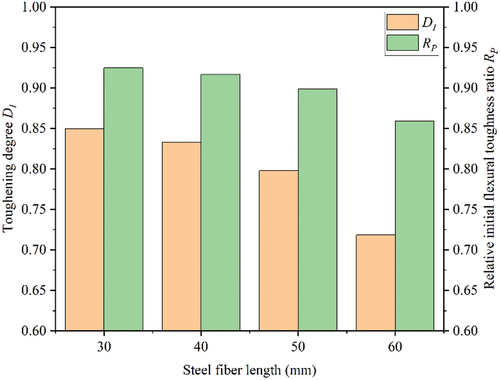
Figure 14. Relative residual flexural toughness ratio Rk of polyurethane concrete with different steel fiber length.
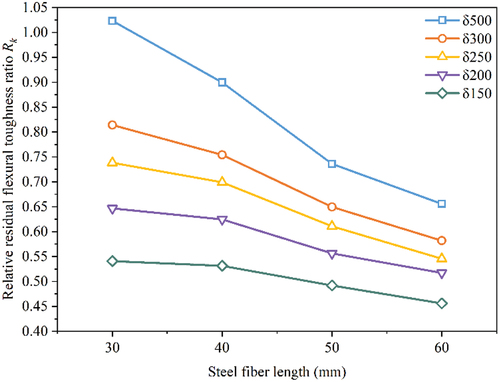
Figure 15. Toughening degree DI and relative initial flexural toughness ratio RP of polyurethane concrete with different steel fiber content.
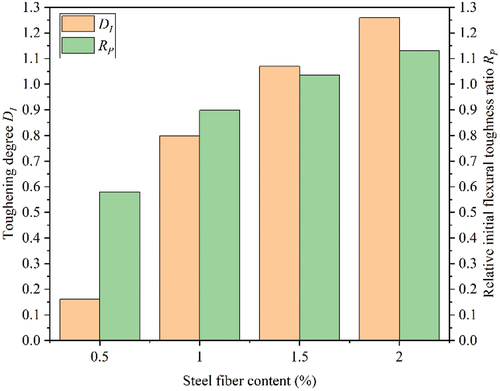
Figure 16. Relative residual flexural toughness ratio Rk of polyurethane concrete with different steel fiber content.
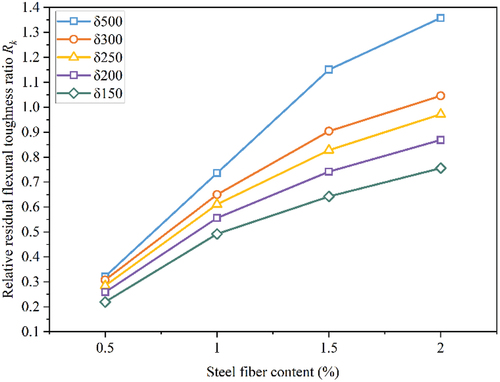
(1) Flexural toughness of polyurethane concrete with different length of steel fibers
As shown in , the toughening degree and relative initial flexural toughness ratio decrease with the increase of steel fiber length. As the steel fiber length increase from 30 mm to 60 mm, the toughening degree and relative initial flexural toughness ratio decreased by 15.4% and 7.1%, respectively. The increase in the length of steel fibers at the same volume content weakens the toughening effect of steel fibers before the peak load on polyurethane concrete.
As shown in , the relative residual flexural toughness ratios at each characteristic displacement decrease continuously with increasing steel fiber length. Under the same volume content, the longer the steel fiber the less the number of steel fibers. Although long fibers are more difficult to pull out from the concrete than short fibers, the number of broken steel fibers is greater than the number of pulled steel fibers due to the high anchoring properties of polyurethane (Abbas, Soliman, and Nehdi Citation2015). The toughening effect of steel fibers in terms of quantity is greater than the effect of the geometric length of steel fibers. Therefore, the toughening effect of long fibers on polyurethane concrete is not as significant as that of short fibers, and the relative residual bending toughness ratios of specimens after cracking decrease continuously with the increase of steel fiber length.
(2) Flexural toughness of polyurethane concrete with different content of steel fiber
As shown in , the toughening degree DI and relative initial flexural toughness ratio of polyurethane concrete go up with the increase of steel fiber admixture, which indicates that the increase of steel fiber content strengthens the pre-peak mechanical behavior of polyurethane concrete. Under the same fiber length, the increase in the amount of steel fiber can make a favorable toughening effect on the plain polyurethane concrete. As shown in , the relative residual flexural toughness ratios of polyurethane concrete also rise continuously with the increase of steel fiber content, which indicates that the increase of steel fiber has an improving effect on the post-peak mechanical behavior of polyurethane concrete.
Compared with the existing flexural toughness evaluation method, the calculation benchmark of the optimized method is the flexural strength of plain polyurethane concrete ƒtmI whose mixture is the same as the steel fiber polyurethane concrete. The calculation benchmark is unified for all specimens, which can clearly characterize the toughening effect of steel fiber, which circumvents the problem of insufficient accuracy caused by different calculation benchmarks. In addition, the concept of toughening degree is introduced to quantify the degree of toughening of specimens by toughening methods, which contributes to the comparability of flexural toughness of engineering materials. In summary, the optimized evaluation method can accurately characterize the toughening effect of the toughening method on the engineering material, and can also accurately identify the differences in flexural toughness between different specimens. It is a flexural toughness evaluation method with clear physical meaning and simple calculation, which provides a new approach to the evaluation of flexural toughness of engineering materials.
4. Conclusions
In this paper, eight 150 mm×150mmx150mm test beams were made, and the influence of steel fiber length and content on flexural performance of polyurethane concrete was studied by four-point bending test. The toughening mechanism of steel fiber on polyurethane concrete matrix was obtained. The evaluation method of flexural toughness of steel fiber polyurethane concrete was improved. The following specific conclusions can be drawn from this study.
Under the same volume ratio and diameter, the fracture ratio of 30 mm steel fiber is 81.6%, and that of 60 mm steel fiber is 69.2%. Polyurethane concrete decreases as the aspect ratio of steel fibers increases. As the length of steel fiber increases from 30 mm to 60 mm, the peak load decreased by 8.6%, and the displacement corresponding to the peak load decreased by 41.1%. The improvement of softening behavior of polyurethane concrete is more significant for shorter fibers than longer fibers, and shorter fiber polyurethane concrete has better flexural toughness.
Under the same length-diameter ratio, the fracture ratio of 0.5% steel fibers is 73.7%, and the fracture ratio of 2.0% steel fibers is 76.0%. Polyurethane concrete increases with the increase of steel fiber volume ratio, from 0.5% to 2.0%, the peak load increased by 49.1%, and the displacement corresponding to the peak load increased by 100.8%. The softening behavior of polyurethane concrete with higher content is better than that of polyurethane concrete with lower steel fiber content.
The existing flexural toughness evaluation method of steel fiber concrete in JG/T 472-2015 standard was optimized to solve the problem that the flexural toughness index calculation benchmark of different specimens is not uniform. When the length of steel fiber increases from 30 mm to 60 mm, and the relative residual flexural toughness ratio decreases. The toughening degree and relative initial flexural toughness ratio decrease by 15.4% and 7.1%, respectively. When the steel fiber volume ratio increased from 0.5% to 2.0%, and the relative residual flexural toughness ratio continued to rise. the toughening degree and relative initial bending toughness ratio increase by 733.3% and 96.6%, respectively. The method can be better used for the calculation and comparison of flexural toughness of actual engineering materials.
In this paper, under the same volume ratio and diameter, it is found that the toughening effect of long steel fiber on polyurethane concrete is not as good as that of short steel fiber. However, the relationship between the distribution form of steel fiber in polyurethane concrete and bending toughness has not been deeply studied, which should be studied in the future.
Acknowledgements
The authors gratefully appreciate Jilin Transportation Innovation Development Support (Science and Technology) Project (2020-1-9) and the support from the Province Key Laboratory of Road in Northeast Forestry University and the project of Transportation Innovation.
Disclosure statement
No potential conflict of interest was reported by the author(s).
Additional information
Funding
Notes on contributors
Zhonglin Sun
Zhonglin Sun is mainly engaged in the research of new composite materials and structures.
Quansheng Sun
Quansheng Sun, Ph.D., Professor, mainly engaged in the research of long-span bridge structure and composite materials.
Yancheng Liu
Yancheng Liu is mainly engaged in the research of new composite materials.
Yanqi Wang
Yanqi Wang is mainly engaged in the research of new bridge deck materials.
Songbai Leng
Songbai Leng specializes in bridge durability and maintenance.
Hongchuan Cui
Hongchuan Cui specializes in bridge durability and maintenance.
Bowen Xu
Bowen Xu specializes in bridge durability and maintenance.
References
- Abbas, S., A. M. Soliman, and M. L. Nehdi. 2015. “Exploring Mechanical and Durability Properties of Ultra-High-Performance Concrete Incorporating Various Teel Fiber Lengths and Dosages.” Construction and Building Materials 75:429–441. https://doi.org/10.1016/j.conbuildmat.2014.11.017.
- AQSIQ. 2006. Chemical Reagent-General Method for the Determination of Density. Beijing: National Standards of the People’s Republic of China.
- AQSIQ. 2010a. Plastics-Polyether Polyols-Part 3: Determination of Hydroxyl Number (GB/T 12008.3). Beijing: National Standards of the People’s Republic of China.
- AQSIQ. 2010b. Plastics.Polyether Polyols.Part 7 :Determination of Viscosity(gb/T 12008.7). Beijing: National Standards of the People’s Republic of China.
- AQSIQ. 2016a. Plastics-Aromatic Isocyanates for Use in the Production of Polyurethane-Part 2: Determination of Hydrolysable Chlorine (GB/T 12009.2). Beijing: National Standards of the People’s Republic of China.
- AQSIQ. 2016c. Plastics-Aromatic Isocyanates for Use in the Production of Polyurethane-Part 5: Determination of Acidity (GB/T 12009.5). Beijing: National Standards of the People’s Republic of China.
- Choi, W.-C., K.-Y. Jung, S.-J. Jang, and H.-D. Yun. 2019. “The Influence of Steel Fiber Tensile Strengths and Aspect Ratios on the Fracture Properties of High-Strength Concrete.” Materials 12 (13): 2105. https://doi.org/10.3390/ma12132105.
- de Alencar Monteiro, V. M., L. Reis Lima, and F. de Andrade Silva. 2018. “On the Mechanical Behavior of Polypropylene, Steel and Hybrid Fiber Reinforced Self-Consolidating Concrete.” Construction and Building Materials 188 (10): 280–291. https://doi.org/10.1016/j.conbuildmat.2018.08.103.
- Ding, Y., G. Liu, A. Hussain, F. Pacheco-Torgal, and Y. Zhang. 2019. “Effect of Steel Fiber and Carbon Black on the Self-Sensing Ability of Concrete Cracks Under Bending.” Construction and Building Materials 207:630–639. https://doi.org/10.1016/j.conbuildmat.2019.02.160.
- Ding, H., Q. Sun, Y. Wang, D. Jia, C. Li, C. Ji, and Y. Feng. 2021. “Flexural Behavior of Polyurethane Concrete Reinforced by Carbon Fiber Grid.” Materials 14 (18): 5421. https://doi.org/10.3390/ma14185421.
- Du, H., and C. Liu. 2021. “Preparation and Properties of Continuous Glass Fiber Reinforced Polyurethane Foam Composite Plate.” Thermosetting Resin 36:31–34. https://doi.org/10.13650/j.cnki.rgxsz.2021.01.007.
- Feng, M., W. Li, X. J. Liu, M.Huang, and J. Yang. 2021. “Copper-Polydopamine Composite Coating Decorating UHMWPE Fibers for Enhancing the Strength and Toughness of Rigid Polyurethane Composites.” Polymer Testing 93:106883. https://doi.org/10.1016/j.polymertesting.2020.106883.
- G.A.o.Q.S. I.Q.o.P.R.o.C. 2015. Molecular Sieve 5A and Its Determination. Beijing: China National Standardization Administration Committee.
- Guo, X., Y. Lu, Y. Sun, J. Wang, H. Li, and C. Yang. 2018. “Effect of Sizing on Interfacial Adhesion Property of Glass Fiber-Reinforced Polyurethane Composites.” Journal of Reinforced Plastics & Composites 37 (5): 321–330. https://doi.org/10.1177/0731684417744664.
- Huang, H., H. Pang, J. Huang, P. Yu, J. Li, Lu M., and Liao B. 2021. “Influence of Hard Segment Content and Soft Segment Length on the Microphase Structure and Mechanical Performance of Polyurethane-Based Polymer Concrete.” Construction and Building Materials 284:122388. https://doi.org/10.1016/j.conbuildmat.2021.122388.
- Hussain, A., Y. Ding, G. Liu, and A. Naqi. 2019. “Study on Self-Monitoring of Multiple Cracked Concrete Beams with Multiphase Conductive Materials Subjected to Bending.” Smart Materials & Structures 28 (9): 095003. https://doi.org/10.1088/1361-665X/ab2cfe.
- Jia, Z., D. Jia, Q. Sun, Y. Wang, and H. Ding. 2021. “Preparation and Mechanical-Fatigue Properties of Elastic Polyurethane Concrete Composites.” Materials 14 (14): 3839. https://doi.org/10.3390/ma14143839.
- Jiang, Z., C. Tang, J. Yang, Y. You, and Z. Lv. 2022. “A Lab Study to Develop Polyurethane Concrete for Bridge Deck Pavement.” International Journal of Pavement Engineering 23 (5): 1404–1412. https://doi.org/10.1080/10298436.2020.1804063.
- Kim, K. C., I. H. Yang, and C. Joh. 2018. “Effects of Single and Hybrid Steel Fiber Lengths and Fiber Contents on the Mechanical Properties of High-Strength Fiber-Reinforced Concrete.” Advances in Civil Engineering 2018 1–14. https://doi.org/10.1155/2018/7826156.
- Lee, K. S., J. Choi,S. E. Park, J. Hwang, and B. Y. Lee. 2018. “Damping Property of Prepacked Concrete Incorporating Coarse Aggregates Coated with Polyurethane.” Cement and Concrete Composites 93:301–308. https://doi.org/10.1016/j.cemconcomp.2018.06.018.
- Lei, W., C. Fang, X. Zhou Y. Li, and Pu M. 2018. “Polyurethane Elastomer Composites Reinforced with Waste Natural Cellulosic Fibers from Office Paper in Thermal Properties.” Carbohydrate Polymers 197:385–394. https://doi.org/10.1016/j.carbpol.2018.06.036.
- Lei, J., F. Feng, S. Xu, W. Wen, and X. He. 2022. “Study on Mechanical Properties of Modified Polyurethane Concrete at Different Temperatures.” Applied Sciences 12 (6): 3184. https://doi.org/10.3390/app12063184.
- Lima, J. M., and J. Brito. 2009. “Inspection Survey of 150 Expansion Joints in Road Bridges.” Engineering Structures 31:1077–1084. https://doi.org/10.1016/j.engstruct.2009.01.011.
- Lima, J. M., and J. Brito. 2010. “Management System for Expansion Joints of Road Bridges.” Structure and Infrastructure Engineering 6:703–714. https://doi.org/10.1080/15732470802087823.
- Li, F., Y. Tan, L. Chen, L. Jing, D. Wu, and T. Wang. 2019. “High Fibre-Volume Silkworm Cocoon Composites with Strong Structure Bonded by Polyurethane Elastomer for High Toughness.” Composites Part A-Applied Science and Manufacturing 125:105553. https://doi.org/10.1016/j.compositesa.2019.105553.
- Li, L., and T. L. Yu. 2022. “Curing Comparison and Performance Investigation of Polyurethane Concrete with Retarders.” Construction and Building Materials 326:126883. https://doi.org/10.1016/j.conbuildmat.2022.126883.
- Magureanu, C., I. Sosa, C. Negrutiu, and B, Heghes. 2012. “Mechanical Properties and Durability of Ultra-High-Performance Concrete.” ACI Materials Journal 109:177–183.
- Ma, R. L., W. Li, M. Huang, M. Feng, and X Liu. 2019. “The Reinforcing Effects of Dendritic Short Carbon Fibers for Rigid Polyurethane Composites.” Composites Science and Technology 170:128–134. https://doi.org/10.1016/j.compscitech.2018.11.047.
- Mastura, M. T., S. M. Sapuan, M. R. Mansor, and A. A. Nuraini. 2018. “Materials Selection of Thermoplastic Matrices for ‘Green’ Natural Fibre Composites for Automotive Anti-Roll Bar with Particular Emphasis on the Environment.” International Journal of Precision Engineering and Manufacturing-Green Technology 5 (1): 111–119. https://doi.org/10.1007/s40684-018-0012-y.
- Meng, L., W. Li, R. Ma, M. Huang, J. Wang, Y. Luo, J. Wang, and K. Xia. 2018. “Long UHMWPE Fibers Reinforced Rigid Polyurethane Composites: An Investigation in Mechanical Properties.” European Polymer Journal 105:55–60. https://doi.org/10.1016/j.eurpolymj.2018.05.021.
- M.O.H.A.U.-R.D.o.t.P.s.R.o. 2015. Steel Fiber Reinforced Concrete (JG/T 472-2015). Ministry of Housing and Urban-Rural Development of the People’s Republic of China. Beijing: Ministry of Housing and Urban-Rural Development of the People’s Republic of China.
- M.O.T.O.T.P.S.R.o. 2005. Test Methods of Aggregate for Highway Engineering (JTG E42-2005). Beijing: Ministry of Transport of the People’s Republic of China.
- M.O.T.O.T.P.S.R.o. 2020. Testing Methods of Cement and Concrete for Highway Engineering (JTG3420-2020). Beijing: Ministry of Transport of the People’s Republic of China.
- Nagarajaiah, S., and S. Narasimhan. 2007. “Seismic Control of Smart Base Isolated Buildings with New Semiactive Variable Damper.” Earthquake Engineering & Structural Dynamics 36:729–749. https://doi.org/10.1002/eqe.650.
- Radzi, A. M., S. M. Sapuan, M. Jawaid, and M. R. Mansor. 2018. “Mechanical Performance of Roselle/Sugar Palm Fiber Hybrid Reinforced Polyurethane Composites.” Bioresources 13 (3): 6238–6249. https://doi.org/10.15376/biores.13.3.6238-6249.
- Sair, S., A. Oushabi, A. Kammouni, O. Tanane, Y. Abboud, and A. Bouari. 2018. “Mechanical and Thermal Conductivity Properties of Hemp Fiber Reinforced Polyurethane Composites.” Case Studies in Construction Materials 8:203–212. https://doi.org/10.1016/j.cscm.2018.02.001.
- Song, W., and J. Yin. 2016. “Hybrid Effect Evaluation of Steel Fiber and Carbon Fiber on the Performance of the Fiber Reinforced Concrete.” Materials 9:704. https://doi.org/10.3390/ma9080704.
- Wang, L., W. Shi, Y. Zhou, et al. 2022. “Adaptive-Passive Tuned Mass Damper for Structural Aseismic Protection Including Soil–Structure Interaction.” Soil Dynamics and Earthquake Engineering 158:107298. https://doi.org/10.1016/j.soildyn.2022.107298.
- Wang, Y., Q. Sun, H. Ding, D. Jia, and C. Li. 2021. “Effect of Binder-Aggregate Ratio on the Mechanical and Functional Properties of Porous Polyurethane Cement Mixture.” International Journal of Pavement Engineering 23 (14): 5101–5117. https://doi.org/10.1080/10298436.2021.1995734.
- Wang, L., Y. Zhou, S. Nagarajaiah, and W. Shi. 2023. “Bi-Directional Semi-Active Tuned Mass Damper for Torsional Asymmetric Structural Seismic Response Control.” Engineering Structures 293:116744. https://doi.org/10.1016/j.engstruct.2023.116744.
- Wang, L., Y. Zhou, W. Shi, et al. 2023. “Seismic Response Control of a Nonlinear Tall Building Under Mainshock-Aftershock Sequences Using Semi-Active Tuned Mass Damper.” International Journal of Structural Stability and Dynamics. https://doi.org/10.1142/S0219455423400278.
- Yahye, M. A., L. Liu, W. U. Honglin, Y. Sun, H. Sun, J. Ma, and L. Zhang. 2022. “Experimental Research on Mechanical Properties of Fiber-Reinforced Polyurethane Elastic Concrete (FRPEC).” Construction and Building Materials 328:126929. https://doi.org/10.1016/j.conbuildmat.2022.126929.
- Yoo a, D.-Y., S.-T. Kang b, and Y.-S. Yoon. 2014. “Effect of Fiber Length and Placement Method on Flexural Behavior, Tension-Softening Curve, and Fiber Distribution Characteristics of UHPFRC.” Construction and Building Materials 64:67–81. https://doi.org/10.1016/j.conbuildmat.2014.04.007.
- Zhang, K., and Q. Sun. 2018. “The Use of Wire Mesh-Polyurethane Cement (WM-PUC) Composite to Strengthen RC T-Beams Under Flexure.” Journal of Building Engineering 15:122–136. https://doi.org/10.1016/j.jobe.2017.11.008.
- Zhao, J. P., L. J. Chen, G. M. Liu, and X. Meng. 2022. “Compressive Properties and Microstructure of Polymer-Concrete Under Dry Heat Environment at 80 °C.” Arabian Journal for Science & Engineering 47 (10): 12349–12364. https://doi.org/10.1007/s13369-021-06405-w.
- Zia, A., Z. Pu, I. Holly, T. Umar, M. A. U. R. Tariq, and M. Sufian. 2022. “A Comprehensive Review of Incorporating Steel Fibers of Waste Tires in Cement Composites and Its Applications.” Materials 15 (21): 7420. https://doi.org/10.3390/ma15217420.

